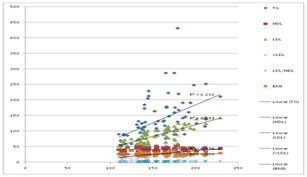Official Journals By StatPerson Publication
|
Table of Content - Volume 9 Issue 2 - February 2019
A study of the association of lipid profile and BMI in children
Kudlappa Angadi1, Raghavendraswami Amoghimath2*
1Assistant Professor, Department of Pediatrics, Mahadevappa Rampure Medical College, Kalaburagi-585101, Karnataka, INDIA. 2Assistant Professor, Department of Pediatrics, Karnataka Institute of Medical Sciences, Hubli-580032, Karnataka, INDIA. Email: drkumarangadi@gmail.com, raghavendra.amoghimath@gmail.com
Abstract Background: Obesity is a widespread and growing problem in the world with significant medical, psychosocial and economic consequences. Aims and Objectives: To Study association of lipid profile and BMI in Children. Methodology: This was a cross sectional study carried out in the Children and adolescents at tertiary health care centre during the one year period i.e. March 2017 to March 2018, so in the one year period there were 80 patients diagnosed with obesity by Body Mass Index (BMI) Growth charts provided by WHO with respect to age and sex was utilized for inclusion of the individuals. The lipid profile in children was carried out by standard protocol. The data analysis was done by co-relation co-efficient and was done SPSS 19 version software. Result: The average age of the children was 10.22 ± 3.62 Yrs. and range was 2-20 Yrs. The average BMI in Obese children was 25.88±4.41. The majority of the patients were males i.e. 51.25% and females were 48.75% there was Correlation between TG (R2=0.232), LDL (R2=0.633), VLDL (R2=0.238) with respect to BMI (R2=0.009) and no co-relation with HDL (R2 =0.000). Conclusion: It can be concluded from our study that the lipid profile was deranged in children if BMI in children increases so, it indicates that child hood obesity may leads to future cardio vascular diseases. Key Word: BMI, Lipid profile, Child hood Obesity.
INTRODUCTION Obesity is a widespread and growing problem in the world with significant medical, psychosocial and economic consequences.1 Widespread reports indicate that the prevalence of obesity among children and adolescents has been increasing in recent years.2,3 In the US, one-third of overweight Americans are at an increased risk of developing chronic disease such as type 2 diabetes, cardiovascular disease and hypertension.4 In children, the development of obesity is associated with the simultaneous deterioration in chronic disease risk profiles, 5 including adult-onset diabetes mellitus, coronary heart disease and respiratory disease.6 In many studies overweight children had abnormal levels of lipids7,8 and a longitudinal change in relative weight was associated with changes in this risk factors.9
METHODOLOGY This was a cross sectional study carried out in the Children and adolescents at tertiary health care centre during the one year period i.e. March 2017 to March 2018, so in the one year period there were 80 patients diagnosed with obesity by Body Mass Index (BMI) Growth charts provided by WHO with respect to age and sex was utilized for inclusion of the individuals. The lipid profile in children was carried out by standard protocol. The data analysis was done by co-relation co-efficient and was done SPSS 19 version software.
RESULT Table 1: Distribution of the patients as per the age and BMI
The average age of the children was 10.22 ± 3.62 Yrs. and range was 2-20 Yrs. The average BMI in Obese children was 25.88±4.41. Table 2: Distribution of the patients as per the sex
The majority of the patients were males i.e. 51.25% and females were 48.75%
Figure 1: Showing Co-relation of Lipid profile with BMI in children
Table 3: Distribution of lipid profile with respect to correlation co-efficient
From above Graph it is clear that there was Correlation between TG (R2=0.232), LDL (R2=0.633),VLDL(R2=0.238) with respect to BMI (R2=0.009) , No correlation with HDL ( R2=0.000).
DISCUSSION Overweight is showing an increasing global trend10. Current estimates suggest that up to 1.7 billion people are overweight or obese world wide. Obesity is increasing all over the word. Over 115 million people are obese and have problems associated with obesity in developing countries11. Overweight problem is increasing continuously in children and adolescents at an alarming pace12,13. Cardiovascular diseases are associated with risk factors such as obesity and dyslipidemia, which, if present during infancy, could continue throughout adult life12,13,14. High serum cholesterol HDL level is associated with longevity as evidence suggest. Low HDL cholesterol level is associated with an increased cardiovascular risk particularly if serum cholesterol and triglycerides are also elevated. The most common primary lipid disorder familial combined hyperlipidemia which is an autosomal dominant condition occurring in 1/200 people could not affect the results of our study with its low incidence. The most common dyslipidemia of obesity is associated with increased triglyceride levels, decreased HDL levels and abnormal LDL cholesterol composition .Accepted risk factors for CVD are elevated LDL and decreased HDL14,15. The average age of the children was 10.22 ± 3.62 Yrs. and range was 2-20 Yrs. The average BMI in Obese children was 25.88±4.41. The majority of the patients were males i.e. 51.25% and females were 48.75% there was Correlation between TG (R2=0.232), LDL (R2=0.633), VLDL(R2=0.238) with respect to BMI (R2=0.009) and no co-relation with HDL (R2 =0.000).
CONCLUSION It can be concluded from our study that the lipid profile was deranged in children if BMI in children increases so, it indicates that child hood obesity may leads to future cardio vascular diseases.
REFERENCES
|
|
 Home
Home

